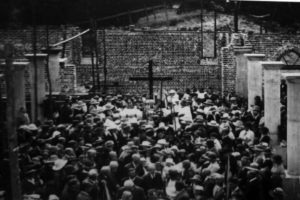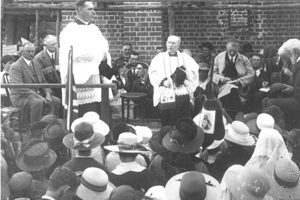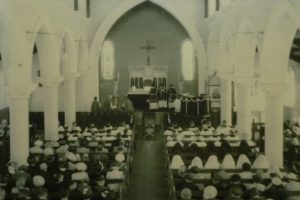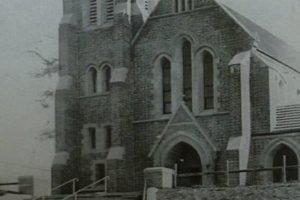The foundation stone of St Patrick’s was laid in 1919. Its doors were opened to the local community just two years later. Some of the older parishioners still recall how local limestone rocks were carried up from the beach on bullock trains, and how, as children, they carried bricks, two at a time, for the exterior works. Others speak of stories they heard from their parents and grandparents about their part in building the Cathedral. Other Bunbury residents again, as well as people from other South West areas, recall watching the Cathedral being built.
Rev Arch Deacon Smythe addressing parishioners after the opening ceremony (1921)The foundation stone of St Patrick’s was laid in 1919. Its doors were opened to the local community just two years later. Some of the older parishioners still recall how local limestone rocks were carried up from the beach on bullock trains, and how, as children, they carried bricks, two at a time, for the exterior works. Others speak of stories they heard from their parents and grandparents about their part in building the Cathedral. Other Bunbury residents again, as well as people from other South West areas, recall watching the Cathedral being built.
Originally St Patrick’s was not a cathedral, but a parish church. However, in 1954 it was proclaimed a cathedral by Pope Pius XII when he established the Catholic Diocese of Bunbury.
Rich in history and heritage, Saint Patrick’s Cathedral played a vital role in the religious aesthetic, spiritual and social fabric of Bunbury, and of the wider South West community, for eighty four years. It was best known for its location, architecture, and as the focal point of the Church’s humanitarian work. It became a major landmark for travellers and a symbol of Bunbury across the southern portion of Western Australia
Bunbury and its surrounding areas are not immune to the pains of modern living, such as domestic violence, drug abuse, a rising road toll. Without the Cathedral, the services the Diocese provides to many thousands of people in Bunbury, and throughout the South West of Australia, would be quantitatively and qualitatively poorer.





































